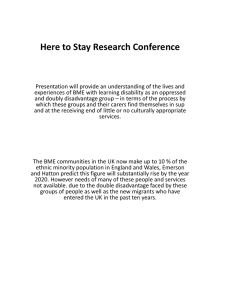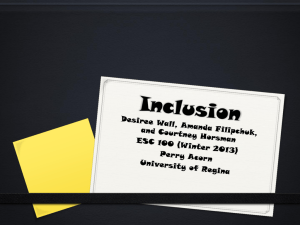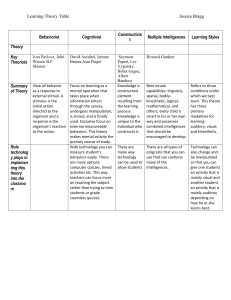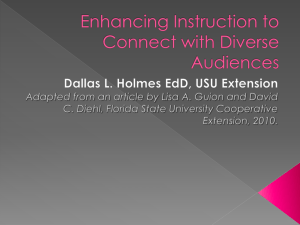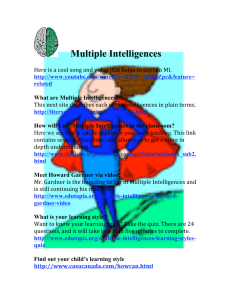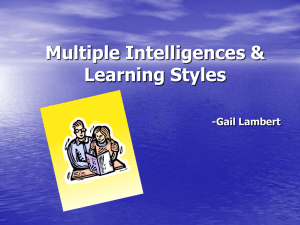Equal Opportunity for All Chapter 11
advertisement
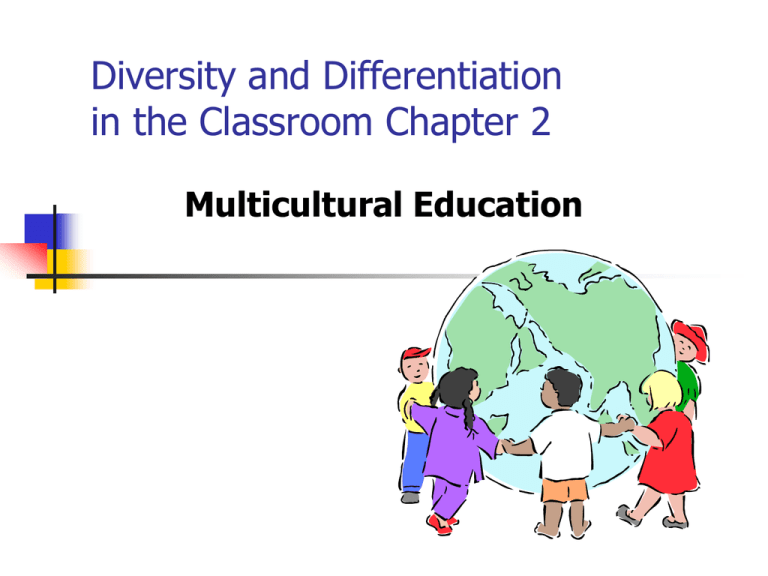
Diversity and Differentiation in the Classroom Chapter 2 Multicultural Education Multicultural Education The educational strategy in which students’ cultural backgrounds are used to develop effective classroom instruction and school environments. It is designed to support and extend the concepts of culture, diversity, equality, social justice, and democracy in the formal school setting. Gollnick and Chinn Culturally responsive teachers develop effective strategies to use with widely diverse groups of students-- Exceptional students Children with disabilities Gifted children Culturally and ethnically diverse students Gender Social class Language diversity All of us belong to many different “microcultural” groups Gender Social Class Ethnic Group The Individual Race Region Religion Giftedness Disability Why is Multicultural Awareness Important? By the year 2020 about half of the United States population will come from groups traditionally labeled minority: African American Asian American Native American Latino or Hispanic While the proportion of diverse students is increasing, the teaching force is becoming more homogeneous. (Harper, et al.) By 2010, an estimated 95% of K-12 teachers will be white middle class females.(Haberman) Most teachers have limited experiences working with cultures unlike their own. (Haberman.) Cultural and Ethnic diversity Theories of cultural blending “Melting Pot” “Cultural Pluralism” or “Salad Bowl” Cultural and Ethnic Diversity Teaching in culturally diverse settings “Culturally assaultive” approaches perpetuate biases and stereotypes Discussion of cultures only as they existed in the past Incorrect or stereotypical versions of how people live Emphasis on differences rather than similarities Token representation of the group in the classroom “Holiday” units on minority groups Cultural and Ethnic Diversity Culturally responsive teaching Acknowledges the legitimacy of the cultural heritages of different ethnic groups Builds bridges of meaningfulness between home and school experiences Uses a wide variety of instructional strategies connected to different learning styles Teaches students to know and praise their own and each others’ cultural heritages Incorporates multicultural information, resources, materials into all subjects Cultural and Ethnic diversity Teaching in culturally diverse settings “Cultural connectiveness” method (infusing multicultural education into daily learning experiences)—suggested steps: Know your community Seek family support Give equal attention to all groups Fill your room with curriculum materials from many cultures Invite visitors to speak Draw from the arts Language Diversity Over 200 languages now in US Ongoing controversy between “English only” and bilingualism Three main terms: ELL (English Language Learners) students who come to school speaking a main language other than English LEP (Limited English Proficient) students who are not yet fluent enough in English to perform school tasks successfully Bilingual – students who speak fluently in English at school and a native language at home Language Diversity Guidelines for bilingual instruction Environmental print Culturally conscious literature Literacy instruction through natural use of reading and writing throughout the curriculum Language buddies Work with the ESL teacher Exceptionalities Children with disabilities Many similarities with non-disabled students Inclusion and “least restrictive environment” Federal Legislation PL 94-142 (Individuals with Disabilities Education Act –IDEA) Individualized Education Plan (IEP) Where are we today with Students with Disabilities? (Data from New Hanover Co. Schools 1997) 25% of SWD were exempt from state tests 50% of students tested for SpEd did not qualify 10% of students had IEPs 60% of students on special route busses missed a day of instruction per week 40 children identified with autism 50%+ of SWD were served in sub-standard classrooms Where are we today with Students with Disabilities? (Data from New Hanover Co. Schools 2006) 100% SWD participate in state tests 90% students tested for SE qualify 14% students have IEPs 95% students on special route busses receive full day of school 100% students receive instruction is classrooms comparable to peers 234 children identified with autism (3rd in state) Some Special Education Program Names ----New Hanover County Intensive Academic Support Intensive Behavior Support Intensive Social/Communication Support Specially Designed Academics-Daily Living Specially Designed Academics—Functional Academics www.nhcs.k12.nc.us/sped/ Exceptionalities -- Teaching children with disabilities—Guidelines Learn something about specific disabilities Maximize interactions between children with disabilities and nondisabled children Individualize your program Assess classroom environment Choose books that help children learn about and appreciate diversity Seek assistance from EC teachers! Exceptionalities -- Gifted Children Characteristics 1. 2. 3. 4. 5. verbal skills abstractions power of concentration intellect behavior Exceptionalities -- Gifted Children- suggestions Faster paced instruction for skills and content based learning More use of inquiry and independent research More advanced materials (higher level reading) Reorganization of content to explore issues across curricular areas Use the Multiple Intelligences approach to reach the tremendous variety of learners! Verbal linguistic Logical mathematical Visual spatial Naturalist Interpersonal Intrapersonal Bodily kinesthetic Musical Word Smart Math Smart Art Smart Nature Smart People Smart Self Smart Body Smart Music Smart Howard Gardner’s Theory of Multiple Intelligences Verbal Linguistic Bodily Kinesthetic Intrapersonal Logical Mathematical Intelligences Interpersonal Visual Spatial Musical Naturalist Verbal Linguistic Logical Mathematical Musical Naturalist Bodily Kinesthetic Intrapersonal Interpersonal Visual Spatial Gardner’s model suggests that Every child has capacities in each of the intelligences Most people can develop each of the intelligences to an adequate level of proficiency The eight intelligences work together in highly complex ways There are many ways to be intelligent in each category Instruction should help children develop all eight intelligences Gender General guidelines Avoid stereotyping masculine and feminine roles Use gender free language when possible Use classroom materials which present an honest view of males and females Balance the contributions of men and women in social studies instruction Social Class Strong relationship between socioeconomic status (SES) and school performance Some explanations for lower achievement of lower SES groups Health, resources, family stress, discrimination Low expectations/low self-esteem Learned helplessness Resistance cultures Tracking Groups to think about: Homeless, migrants, children in poverty The majority of children in the South’s schools (54%) are POOR! 49% of children in NC are low income This is a great challenge because low income students as a group begin school less ready, are the most likely to drop out, perform at the lowest levels on tests, and have the least access to college. Social Class What can be done? One suggestion: Eliminate tracking/ability grouping (Students should be grouped according to the specific skills they need, and when instruction is completed, the group should be disbanded.) Group children in various way, and change the groups often. Social Class – Key Points from A Framework for Understanding Poverty by Ruby Payne 1. 2. 3. Schools and businesses operate from middle class norms and use the hidden rules of the middle class. For students to be successful, we must understand their hidden rules and teach them the rules that will make them successful at school and at work. We can neither excuse students nor scold them for not knowing; as educators we must teach them and provide support, insistence, and expectations. An interview with Ruby Payne-What are some common misperceptions educators may have about children who come from a low-income background, especially if they are not accustomed to teaching low-income children? Payne: That the students from poverty are not intelligent and that students engage in behaviors that make no sense. To survive in poverty, you must be very nonverbal, reactive, and sensory-based. To survive in school and work, you must be very verbal, very abstract, and very proactive (you must plan.) Abstract means that you can live in a representational world. For example, when a check is written, the understanding is that it represents money that is in the bank as opposed to cash, which is actual money. Interview with Ruby Payne-- What are some strategies teachers can employ to help make lessons more relevant and understandable for children of all social classes? Payne: We recommend these interventions: Build relationships of mutual respect with students. Use direct teach processes. This means that you are very specific in the steps and procedures needed to do something. For example, a recipe has amounts of ingredients but will also tell the steps or order that must be followed to make the item. And in school, often the processes are not identified or written down so they can be consistently followed. Use mental models. Mental models help translate between the sensory and the abstract worlds. Just as a blueprint translates between the conversation about a house and the actual finished house in the three dimensions, so a mental model translates between abstract constructs and the sensory world. Teach that there are two sets of rules -- one for school and work, one for outside of school and work. Eight home-based factors correlated with student achievement and eight that don’t matter (data from late 1990s US Dept of Education Early Childhood Longitudinal Study to measure the academic progress of more than 20000 children from grades K-5—subjects chosen from across the country to represent an accurate cross section of American school children.) The child has highly educated parents. The child’s family is intact. The child’s parents have high socioeconomic status. The child’s parents recently moved into a better neighborhood. The child’s mother was thirty or older at the time of her first child’s birth. The child’s mother didn’t work between birth and kindergarten. The child had low birth weight. The child attended Head Start. The child’s parents speak English in the home. The child’s parents regularly take him to museums. The child is adopted. The child is regularly spanked. The child’s parents are involved in the PTA. The child frequently watches television. The child has many books in his home. The child’s parents read to him nearly every day. Importance of “connectedness” “Good teachers possess a capacity for connectedness. They are able to weave a complex web of connectedness among themselves, their subjects, and their students so that students can learn to weave a world for themselves. The methods used by these weavers vary widely: lectures, Socratic dialogues, laboratory experiments, collaborative problem solving, creative chaos. The connections made by good teachers are held not in their methods but in their hearts— meaning heart in its ancient sense, as the place where intellect and emotion and spirit and will converge in the human self.” From The Courage To Teach by Parker J. Palmer
